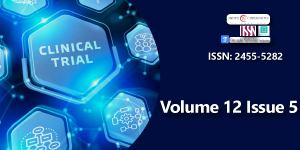Spatial Analysis of COVID-19 Case Clusters and Vaccination Gaps in Sri Lanka: A Spatial Review of COVID-19 Trends in Colombo District, Sri Lanka
Main Article Content
Abstract
Abstract
This review examines how spatial analysis techniques have been applied globally and locally to understand COVID-19 transmission and vaccine accessibility, with a focus on the Colombo District of Sri Lanka. The COVID-19 pandemic revealed critical vulnerabilities in public health systems, particularly in densely populated urban regions. This review examines the role of spatial analysis in understanding and addressing COVID-19 transmission and vaccination accessibility in Sri Lanka, with a specific focus on the Colombo District. Drawing on global and national literature, the study explores how Geographic Information Systems (GIS), spatial statistics, and remote sensing were employed to map infection clusters, analyze social vulnerability, and identify gaps in health service delivery. Spatial tools such as Kernel Density Estimation (KDE), Getis-Ord Gi*, and network accessibility models were instrumental in highlighting persistent clusters in socioeconomically disadvantaged neighborhoods. The review also assesses how spatial planning informed the deployment of mobile vaccination units to underserved areas, to overcome geographical and digital barriers. Finally, the paper offers strategic policy recommendations to institutionalize spatial epidemiology within Sri Lanka’s public health governance, advocating for the integration of real-time GIS dashboards, centralized geospatial health units, and capacity building for health professionals. The findings underscore the transformative potential of spatial intelligence in pandemic preparedness, response, and equity-focused health planning. This review synthesizes previously published data and findings and official dashboards.
Downloads
Article Details
Copyright (c) 2025 Dissanayake DMDOK.

This work is licensed under a Creative Commons Attribution 4.0 International License.
World Health Organization. WHO Director-General’s opening remarks at the media briefing on COVID-19 - 11 March 2020. 2020. Available from: https://www.who.int
Rader B, Scarpino SV, Nande A, Hill AL, Adlam B, Reiner RC, et al. Crowding and the shape of COVID-19 epidemics. Nat Med. 2020;26:1829–34. Available from: https://www.nature.com/articles/s41591-020-1104-0
Epidemiology Unit. COVID-19 Situation Reports. Ministry of Health, Sri Lanka. 2021.
Fernando N, Jayasekara S. COVID-19 dynamics in urban slums of Colombo. Sri Lankan J Epidemiol. 2021;4(1):33–41.
WHO Sri Lanka. COVID-19 Vaccine Situation Report. 2021. Available from: https://www.who.int/srilanka
Desjardins MR, Hohl A, Delmelle EM. Rapid surveillance of COVID-19 in the US using spatial scan statistics. Int J Environ Res Public Health. 2020;17(10):3510. Available from: https://www.mdpi.com/1660-4601/17/10/3510
Kang D, Choi H, Kim JH, Choi J. Spatial epidemic dynamics of the COVID-19 outbreak in China. Int J Infect Dis. 2020;94:96–102. Available from: https://www.ijidonline.com/article/S1201-9712(20)30176-4/fulltext
Mollalo A, Vahedi B, Rivera KM. GIS-based spatial modeling of COVID-19 incidence rate in the US. Sci Total Environ. 2020;728:138884. Available from: https://www.sciencedirect.com/science/article/pii/S0048969720323847
Leal-Neto OB, Santos FAS, Lee JY, Albuquerque JO, Souza WV. Prioritizing COVID-19 tests using participatory surveillance and spatial scanning. Int J Med Inform. 2020;143:104263. Available from: https://www.sciencedirect.com/science/article/pii/S1386505620303925
Kamel Boulos MN, Geraghty EM. Geographical tracking and mapping of coronavirus cases worldwide. Int J Health Geogr. 2020;19:8. Available from: https://ij-healthgeographics.biomedcentral.com/articles/10.1186/s12942-020-00202-8
Weerasinghe P, Dahanayake N, Seneviratne K. GIS tools for pandemic risk mapping in Sri Lanka. Sri Lankan J GIS Remote Sens. 2022;11(1):15–29.
Weerakoon D. Mapping COVID-19 vaccine accessibility in Sri Lanka. J Geospat Health. 2022;17(1):39–48.
Amarasinghe T. GIS-enabled mobile vaccination in underserved urban areas of Sri Lanka. Asian J Public Health. 2022;8(2):121–9.
Santos R, Souza C, Cardoso D. Lessons from GIS-based pandemic planning in Brazil. Health Place. 2021;68:102514.
Perera H, Wijesinghe R, Dissanayake M. Urban COVID-19 spatial clustering in Colombo District. Colombo Urban Health Rev. 2021;3(2):45–58.
Liu C. Role of pollution and climate in the COVID-19 pandemic: Spatial analysis. Environ Res. 2020;191:110189.
Rahman KM. Accessibility analysis of COVID-19 vaccination sites in South Asia. GeoHealth. 2021;5(9):e2021GH000500.
Ahmed S, Hasan M, Roy T. GIS-based travel time analysis to hospitals in Dhaka. Health Place. 2022;73:102737.
Silva L. Community vulnerability and COVID-19 case distribution in Colombo. Asian Geogr. 2021;38(1):66–78.
Basu R. Urban slums and pandemic vulnerability: Case study of Dharavi, Mumbai. Health Place. 2021;67:102487.
Mburu G. COVID-19 preparedness in informal settlements in sub-Saharan Africa. Glob Health Action. 2021;14(1):1880605.
Jayasinghe L. Accessibility challenges in Colombo’s GN Divisions during the COVID-19 pandemic. J South Asian Urban Stud. 2022;7(1):55–68.
WHO Sri Lanka. Mobility Insights Reports. 2021. Available from: https://www.who.int/srilanka
Gavi – The Vaccine Alliance. COVID-19 Vaccine Equity Dashboard. 2021. Available from: https://www.gavi.org
Patel R. Spatial and social disparities in COVID-19 vaccine distribution in India. Indian J Community Med. 2021;46(3):341–9.
Jayasinghe L. Gendered implications of COVID-19 vaccination accessibility in Sri Lankan urban neighborhoods. J South Asian Public Health. 2022;5(2):93–105.
World Health Organization. Guidance on spatial analysis in public health. 2021. Available from: https://www.who.int/publications/i/item/spatial-epidemiology-guidance
Park YJ, Choe YJ, Park O, Park SY, Kim YM, Kim J, et al. Contact tracing during coronavirus disease outbreak, South Korea. Emerg Infect Dis. 2020;26(10):2465–8. Available from: https://wwwnc.cdc.gov/eid/article/26/10/20-1315_article
Dong E, Du H, Gardner L. An interactive web-based dashboard to track COVID-19 in real time. Lancet Infect Dis. 2020;20(5):533–4. Available from: https://www.thelancet.com/journals/laninf/article/PIIS1473-3099(20)30120-1/fulltext
CDC Thailand. Early Warning and Response System (EWARS). 2021. Available from: https://ddc.moph.go.th
NYC Health. COVID-19 Neighborhood Health Dashboard. 2021. Available from: https://www.nyc.gov/covid-dashboard
Africa CDC. Africa Health GeoPortal. 2022.
WHO Philippines. GIS training for COVID-19 Response. 2021. Available from: https://www.who.int/philippines/news/detail/

